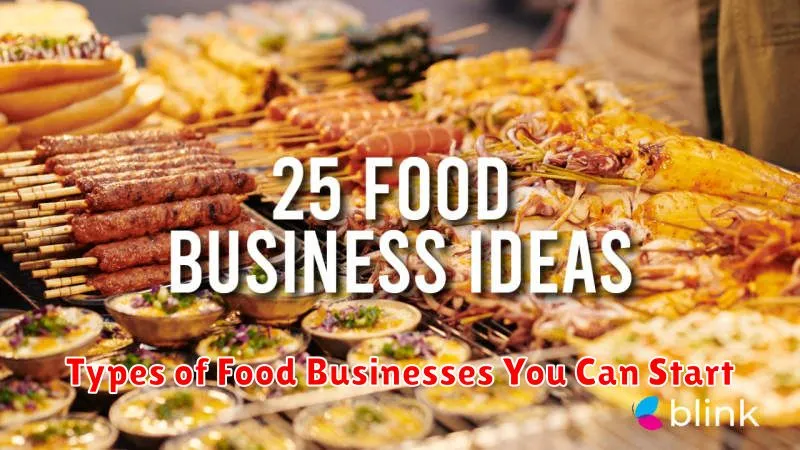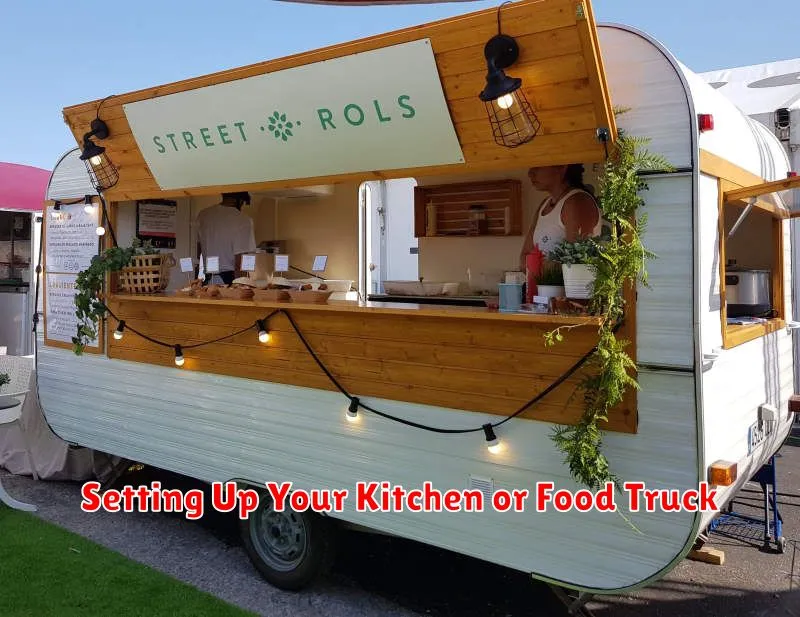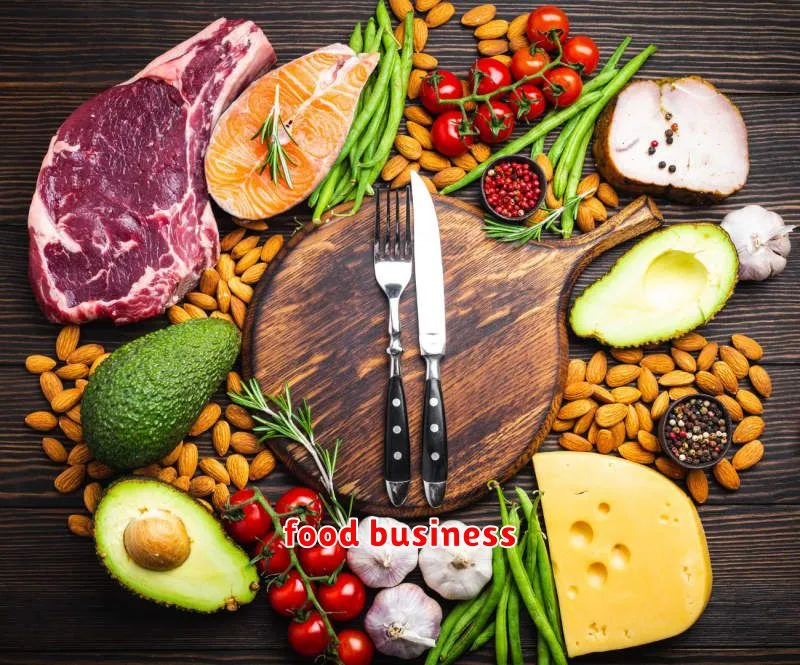Starting a food business can be a delicious and rewarding journey, but it also requires careful planning and execution. This step-by-step guide will walk you through the essential steps of launching your own successful food business, from developing a winning business plan and securing funding to navigating food safety regulations and building a strong brand. Whether you’re dreaming of opening a restaurant, launching a food truck, or creating a home-based food business, this comprehensive guide provides the practical advice and actionable strategies you need to turn your culinary passion into a profitable venture. Learn how to overcome common challenges and achieve your food business goals with our expert insights.
Types of Food Businesses You Can Start

The food industry offers a diverse range of business opportunities. Choosing the right type depends on your skills, resources, and market analysis.
Food trucks and carts offer mobility and lower overhead compared to brick-and-mortar establishments. They are ideal for testing concepts and reaching diverse customer bases.
Restaurants, ranging from casual eateries to fine dining establishments, provide a more established and potentially higher-profit model. However, they require significant investment and operational expertise.
Catering businesses focus on providing food services for events and functions, offering flexibility and the potential for large-scale orders. Strong organizational and logistical skills are vital.
Specialty food stores, like bakeries, butchers, or gourmet shops, cater to niche markets and can build a loyal customer base. Success relies on product quality and exceptional customer service.
Meal prep services offer prepared meals for busy individuals and families, often delivered or picked up. This business model requires efficient production and strong marketing.
Online food businesses, including online ordering platforms and food delivery services, leverage technology to connect customers with food providers. A strong digital presence is crucial for success.
Grocery stores, from small independent stores to large supermarket chains, cater to consumer demand for a wide array of food products. This requires significant capital investment and supply chain management expertise.
Ultimately, the best type of food business for you will depend on a careful evaluation of your resources, market demand, and personal preferences.
Understanding Licensing and Health Regulations
Starting a food business requires navigating a complex web of licensing and health regulations. These vary significantly by location, so thorough research is crucial. Begin by identifying your local health department and reviewing their specific requirements.
Food service permits are fundamental. These licenses grant you the legal permission to operate a food establishment, often involving inspections to ensure compliance with safety standards. The application process usually requires details about your business structure, location, menu, and equipment.
Health regulations focus on food safety. Expect inspections covering areas like food handling, storage, preparation, and sanitation. Compliance with these regulations is mandatory and can involve rigorous adherence to temperature controls, pest control measures, and employee hygiene practices. Regular training for staff on proper food handling is essential.
Beyond basic permits, you might need additional licenses depending on your business model. For example, businesses selling specific products (e.g., alcohol, dairy) may require specialized licenses. It’s advisable to consult with relevant authorities or legal professionals to ensure complete regulatory compliance.
Failing to obtain the necessary licenses or violating health regulations can result in heavy fines, business closure, or even legal action. Proactive compliance is key to building a successful and sustainable food business.
How to Choose a Profitable Food Niche
Selecting a profitable food niche is crucial for your food business’s success. Thorough market research is key. Analyze current trends – what foods are in high demand? Consider your own skills and passions; aligning your business with your strengths increases your likelihood of success.
Identify a target audience. Who are you selling to? Understanding their demographics, preferences, and dietary needs helps you tailor your offerings. Research competition within your chosen niche. What are their strengths and weaknesses? How can you differentiate your business?
Evaluate the profitability of your potential niche. Consider production costs, pricing strategies, and potential profit margins. A niche with high demand and lower production costs is generally more profitable. Don’t underestimate the importance of scalability; choose a niche that allows for growth and expansion.
Finally, consider your resources. Do you have the necessary equipment, skills, and capital to successfully operate within your chosen niche? A realistic assessment of your resources helps prevent future challenges. Remember that a unique selling proposition (USP) is essential; what sets your business apart from the competition?
Creating a Menu and Testing Recipes
Developing your menu is a crucial step in starting a food business. Consider your target audience, market trends, and your unique selling proposition (USP) when selecting dishes. A well-balanced menu offers variety while showcasing your culinary strengths. Start with a smaller, manageable menu to avoid overwhelming yourself and your kitchen.
Before launching your menu, thorough recipe testing is essential. Refine each recipe to ensure consistent quality, taste, and cost-effectiveness. Consider factors like portion sizes, ingredient sourcing, and preparation time. Gather feedback from friends, family, or focus groups to identify areas for improvement and to gauge customer preferences.
Document all your tested recipes meticulously, including ingredient quantities, preparation instructions, and cost breakdowns. This detailed record will be invaluable for consistent food production, staff training, and menu management as your business grows. Remember to factor in potential recipe scaling to meet varying demand.
Finally, consider the pricing strategy for your menu. Factor in your food costs, labor, overhead, and desired profit margin to set prices that are both competitive and profitable. A well-tested and thoughtfully priced menu will contribute significantly to your food business’s success.
Setting Up Your Kitchen or Food Truck

Establishing your kitchen or food truck is crucial for a successful food business. This involves securing a suitable location, obtaining necessary permits and licenses, and equipping the space with essential equipment.
For a brick-and-mortar kitchen, consider factors like size, location, accessibility, and lease terms. Ensure it meets all health and safety regulations. A food truck requires a different approach; find a location that allows food trucks and ensures easy access to utilities and parking.
Regardless of your choice, thorough planning is key. Create a detailed layout optimized for workflow efficiency. Invest in high-quality, commercial-grade equipment suitable for your menu and volume of business. This includes ovens, refrigerators, freezers, cooking ranges, and preparation tables. Remember to factor in storage space for ingredients and supplies.
Prioritize compliance with health codes. Maintain a clean and organized workspace. Proper ventilation and waste disposal systems are essential. Regular inspections and maintenance are crucial for avoiding potential issues and ensuring ongoing compliance.
Finally, ensure your setup is designed for both efficiency and safety. Consider ergonomics, employee safety, and fire prevention measures to create a productive and secure environment for your team.
Packaging, Branding, and Labeling Requirements
Packaging for food products must prioritize food safety and preservation. Choose materials that are durable, protect against contamination, and are appropriate for your product’s shelf life. Consider factors like temperature resistance, moisture barrier, and oxygen permeability.
Branding is crucial for establishing your food business’s identity and attracting customers. Develop a strong brand name, logo, and visual identity that reflects your product’s values and target market. Consistent branding across all packaging and marketing materials is essential.
Labeling is legally mandated and vital for consumer information and safety. Your labels must clearly display the product name, ingredients list (in descending order of weight), net weight, manufacturer’s information, and any relevant allergen warnings. Compliance with FDA regulations (or equivalent in your region) is paramount. Accurate nutrition facts are also required.
Careful consideration of packaging, branding, and labeling will not only ensure compliance but also contribute significantly to your product’s success in the market. Investing in high-quality packaging and a strong brand identity communicates professionalism and builds consumer trust.
Marketing and Selling Your Food Products
Successfully marketing and selling your food products requires a multi-faceted approach. Begin by defining your target audience; understanding their preferences, needs, and purchasing habits is crucial. This informs your branding and messaging.
Develop a strong brand identity, including a memorable logo and consistent visual presentation. Craft a compelling brand story that resonates with your target market and highlights your unique selling proposition (USP).
Pricing your products strategically is key. Consider your production costs, market competition, and perceived value. Explore various sales channels, such as farmers’ markets, online stores, retail partnerships, and wholesale distribution, choosing those best suited to your product and target market.
Leverage digital marketing tools like social media, email marketing, and a professional website to reach a wider audience. Engage in content marketing by sharing recipes, behind-the-scenes content, and other valuable information to build a loyal following.
Packaging is critical; it should be attractive, functional, and informative. Consider using high-quality materials and highlighting key information like ingredients, nutritional facts, and storage instructions. Customer service is paramount; build strong relationships with your customers through responsive communication and excellent product quality.
Finally, continuously monitor sales data and customer feedback to refine your marketing strategies and improve your offerings. Adaptability and a commitment to quality are essential for long-term success.
Scaling from Home-Based to Commercial Operations
Transitioning your food business from a home-based operation to a commercial one requires careful planning and execution. Significant changes are needed to meet legal and safety standards.
First, secure the necessary licenses and permits. These requirements vary by location and the type of food you produce. Consult your local health department and regulatory agencies for specific details. You’ll need to ensure your commercial kitchen meets stringent health and safety codes, including proper ventilation, equipment, and sanitation practices.
Next, address production capacity. Scaling up means investing in commercial-grade equipment and potentially hiring staff. Develop a comprehensive business plan outlining your projected growth, funding needs, and marketing strategy. This plan will be vital for securing loans or attracting investors.
Distribution and logistics must also be carefully considered. You may need to establish relationships with wholesalers, distributors, or retailers. Consider packaging and labeling requirements to ensure your product meets all legal and consumer expectations.
Finally, financial management is critical. Track your expenses, monitor your profitability, and plan for potential challenges. Seek professional advice from a business consultant or accountant to ensure sustainable growth.

